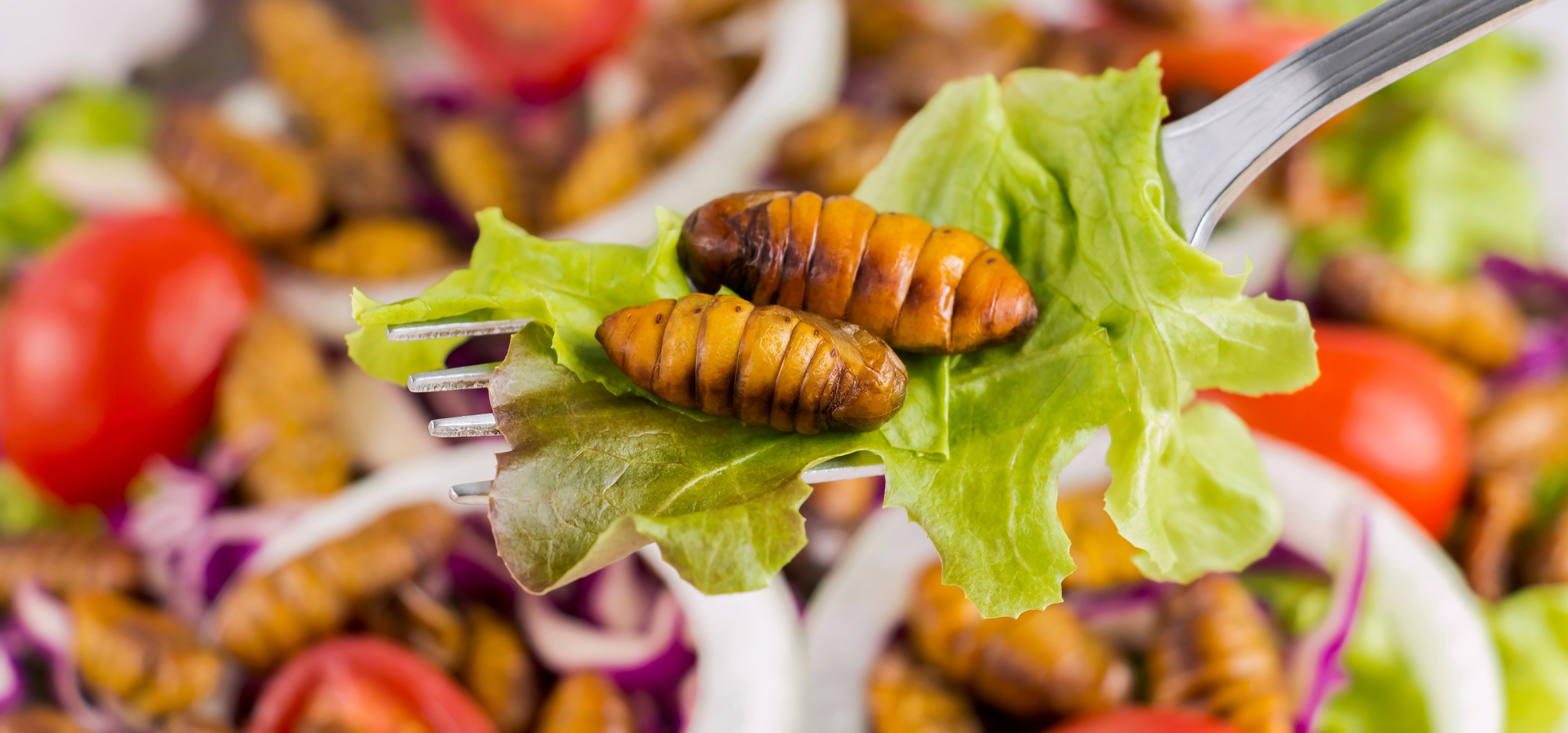[ad_1]
Dr Janina Seubert believes the path to healthier human diets is through the nose.
Seubert, a cognitive neuroscientist at the Karolinska Institute in Sweden, is researching the role of smell in shaping public preferences towards foods. She’s curious whether scents could help people embrace protein sources such as insects as alternatives to meat and dairy.
Breaking habits
Alternative proteins also include microalgae and the cells of microorganisms like bacteria and yeast – a group known as “single-cell proteins”. Featuring more of these protein sources in human diets can not only improve nutrition but also ease environmental pressure caused by the worldwide breeding of livestock.
The challenge for researchers like Seubert is to unlock the secrets to people’s willingness to abandon familiar foods and embrace novel ones, which include the likes of crickets.
‘So many things about how smell actually works are not properly understood,’ she said.
Seubert leads a project that received EU funding to learn more about how flavour preferences are formed in the human brain. Called OLFLINK, it runs for five years through April 2026.
Production of traditional proteins via livestock farming threatens to worsen climate change, hasten biodiversity loss and strain water supplies. That’s because it requires vast tracts of land, consumes large amounts of water and is a major greenhouse-gas emitter.
The worldwide market for animal-based proteins is estimated to be worth more than €1.3 trillion. By comparison, the market for alternative proteins is valued at about €13 billion.
In addition to their smaller environmental footprint, non-traditional proteins could also help ensure quality food supplies for a growing global population.
Learning by smelling
Seubert uses brain scans to compare physiological reactions to familiar and unfamiliar food flavours. This allows her to understand the emotional processes that attract people to familiar foods and what happens when people begin to like something new.
She has found that, in contrast to generally disliked tastes such as bitterness, the positive or negative association of smells with certain foods is learned over time. People tend to like aromas that have traditionally been paired with a rewarding taste – for example sweetness, which indicates the presence of carbohydrates.
“
So many things about how smell actually works are not properly understood.
‘If we cannot identify a smell as a specific food, we tend not to like it very much,’ said Seubert, who comes from Germany.
She said people tend to compare alternative food ingredients with familiar existing products and, as a result, initially find the unfamiliar ones unpleasant.
Seubert cited the example of oat milk: people might at first regard it as a variant of milk that has a “wrong smell” before they grow to like the alternative the more often they drink it.
Her research indicates that people may be more sensitive to new smells when hungry, suggesting that the context in which food is consumed helps determine how easily it can get accepted.
Seubert’s laboratory is investigating how changing the external context by, for example, providing a pleasant atmosphere or increasing knowledge about the origin of the novel flavour can speed up acceptance.
One of her next steps will be to use such contextual changes to assess the consumer potential of a protein derived from mealworm.
‘In my lab, we will study the impact of both internal factors such as hunger and external factors such as background knowledge to develop a liking for the smells of foods with proteins from insects,’ said Seubert.
Mealworm, which is the larva of the meal beetle, is packed with proteins and can be eaten cooked, raw or as a powder. It is now mainly used as food for birds and other animals that eat insects and worms.
Microalgae and single-cell proteins also get turned into powders that are high in protein, minerals and vitamins.
Nourishing powders
The nutritional, environmental and popular aspects of alternative proteins were all tackled by another EU-funded research project that has just ended after four years.
Called NextGenProteins, it focused on the production of insects, microalgae and single-cell proteins for both human food and animal feed.
Birgir Örn Smárason, who led the project, hailed food powders from all three sources that emerged.
‘They have high protein content, some minerals and vitamins and can be added as an extra or to replace more traditional ingredients in food products,’ said Smárason, a research group leader at Icelandic food and biotechnology research and development company Matís.
Currently, the world’s appetite for protein comes mainly from animal farming for meat and dairy.
NextGenProteins studied the environmental impact of the three new protein sources together with their potential to be re-used.
Green gains
The researchers discovered that spirulina, a protein powder made from microalgae by the project partners, uses less than 1% of the land, water and emissions required to produce beef. Insects had an even smaller land use: 1 000 times lower than that of red meat.
“
The alternative proteins are very sustainable compared to most traditional food products.
Under the project, black soldier flies were transformed into animal feed and pet food, while crickets were turned into food for humans. Both final products also came in the form of a dried powder.
‘It’s an easy material to work with and add protein,’ Smárason said.
Meanwhile, the single-cell proteins were created from wood residues and leftovers from forestry.
This waste, which can’t be used for other types of food production, was broken down with chemicals and then fermented with yeast to create another protein-rich powder that can be used directly in food and feed.
‘In all cases, the alternative proteins are very sustainable compared to most traditional food products that we consume,’ Smárason said.
Pleasant surprises
The NextGenProteins team informed people about how the proteins are made to overcome initial scepticism.
‘We firmly believe that, by educating consumers, we can make a big step forward towards more sustainable diets and food systems,’ Smárason said.
The team also sought feedback through taste events, discussions and other exchanges. One online survey covered 6 600 people in Finland, Germany, Iceland, Italy, Poland, Sweden and the UK.
The team discovered that many people were already very positive towards alternative proteins.
More than half of Europeans are in favour of microalgae and only a slightly lower level of support exists for single-cell proteins.
‘We were surprised by the positive results,’ Smárason said.
Colour considerations
Still, he said that people surveyed showed a great deal more reluctance about eating insects because of a perception that they are generally repulsive.
‘People usually think “yuck, insects” when they think about eating whole insects,’ Smárason said.
While the project’s cricket-based protein powder was designed to help overcome this hurdle, the surveys still indicated that only one in three Europeans is willing to take a bite of the bugs.
Smárason noticed that colour also plays a big role in accepting novel food products.
The project’s spirulina powder made from microalgae originally had a very intense green colour, which made it tough to integrate into everyday food items.
‘During our trials, we baked bread that was so green it was hard to convince consumers to taste it,’ Smárason said.
The researchers managed to isolate the protein and took out the blue-green pigments, which are now sold as valuable colourants for other food products. This lets the protein still be added to food while looking appetising.
‘Now we have a microalgae powder that is almost colourless, slightly brown or green – whatever fits best into the final product,’ Smárason said.
Research in this article was funded by the EU via the European Research Council (ERC). If you liked this article, please consider sharing it on social media.
Food 2030
The EU is seeking to spur a transition towards sustainable, healthy and inclusive food systems through its research and innovation policy framework known as “Food 2030”.
Food 2030 is driven by an awareness that current production and consumption patterns are affected by and contribute to crises including malnutrition, climate change, biodiversity loss and resources scarcity.
The framework brings together research and innovation players in different areas to tackle interconnected challenges through a systemic and multi-actor approach.
The main goals include developing knowledge and impactful solutions fostering sustainable healthy diets; climate-friendly, environmentally smart and circular food systems; and resilient and empowered communities. Other top goals are encouraging new business models, capacity building and education for a just and fair food-systems transition respecting planetary boundaries.
This article is relevant to the Food 2030 Pathway on alternative proteins and dietary shift.
[ad_2]
Source link


